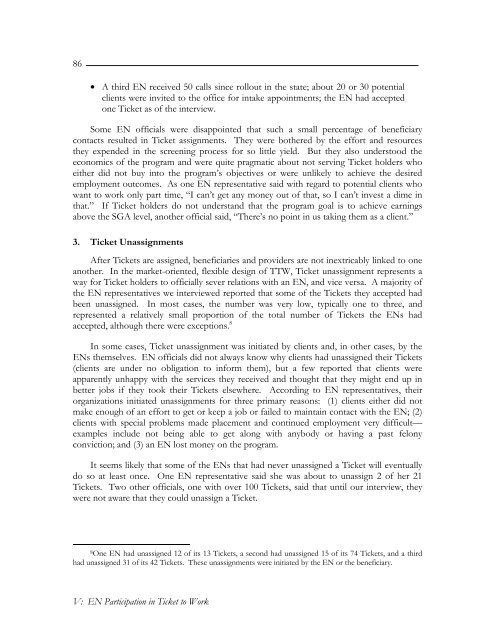Evaluation of the Ticket to Work Program, Implementation ...
Evaluation of the Ticket to Work Program, Implementation ...
Evaluation of the Ticket to Work Program, Implementation ...
Create successful ePaper yourself
Turn your PDF publications into a flip-book with our unique Google optimized e-Paper software.
86• A third EN received 50 calls since rollout in <strong>the</strong> state; about 20 or 30 potentialclients were invited <strong>to</strong> <strong>the</strong> <strong>of</strong>fice for intake appointments; <strong>the</strong> EN had acceptedone <strong>Ticket</strong> as <strong>of</strong> <strong>the</strong> interview.Some EN <strong>of</strong>ficials were disappointed that such a small percentage <strong>of</strong> beneficiarycontacts resulted in <strong>Ticket</strong> assignments. They were bo<strong>the</strong>red by <strong>the</strong> effort and resources<strong>the</strong>y expended in <strong>the</strong> screening process for so little yield. But <strong>the</strong>y also unders<strong>to</strong>od <strong>the</strong>economics <strong>of</strong> <strong>the</strong> program and were quite pragmatic about not serving <strong>Ticket</strong> holders whoei<strong>the</strong>r did not buy in<strong>to</strong> <strong>the</strong> program’s objectives or were unlikely <strong>to</strong> achieve <strong>the</strong> desiredemployment outcomes. As one EN representative said with regard <strong>to</strong> potential clients whowant <strong>to</strong> work only part time, “I can’t get any money out <strong>of</strong> that, so I can’t invest a dime inthat.” If <strong>Ticket</strong> holders do not understand that <strong>the</strong> program goal is <strong>to</strong> achieve earningsabove <strong>the</strong> SGA level, ano<strong>the</strong>r <strong>of</strong>ficial said, “There’s no point in us taking <strong>the</strong>m as a client.”3. <strong>Ticket</strong> UnassignmentsAfter <strong>Ticket</strong>s are assigned, beneficiaries and providers are not inextricably linked <strong>to</strong> oneano<strong>the</strong>r. In <strong>the</strong> market-oriented, flexible design <strong>of</strong> TTW, <strong>Ticket</strong> unassignment represents away for <strong>Ticket</strong> holders <strong>to</strong> <strong>of</strong>ficially sever relations with an EN, and vice versa. A majority <strong>of</strong><strong>the</strong> EN representatives we interviewed reported that some <strong>of</strong> <strong>the</strong> <strong>Ticket</strong>s <strong>the</strong>y accepted hadbeen unassigned. In most cases, <strong>the</strong> number was very low, typically one <strong>to</strong> three, andrepresented a relatively small proportion <strong>of</strong> <strong>the</strong> <strong>to</strong>tal number <strong>of</strong> <strong>Ticket</strong>s <strong>the</strong> ENs hadaccepted, although <strong>the</strong>re were exceptions. 8In some cases, <strong>Ticket</strong> unassignment was initiated by clients and, in o<strong>the</strong>r cases, by <strong>the</strong>ENs <strong>the</strong>mselves. EN <strong>of</strong>ficials did not always know why clients had unassigned <strong>the</strong>ir <strong>Ticket</strong>s(clients are under no obligation <strong>to</strong> inform <strong>the</strong>m), but a few reported that clients wereapparently unhappy with <strong>the</strong> services <strong>the</strong>y received and thought that <strong>the</strong>y might end up inbetter jobs if <strong>the</strong>y <strong>to</strong>ok <strong>the</strong>ir <strong>Ticket</strong>s elsewhere. According <strong>to</strong> EN representatives, <strong>the</strong>irorganizations initiated unassignments for three primary reasons: (1) clients ei<strong>the</strong>r did notmake enough <strong>of</strong> an effort <strong>to</strong> get or keep a job or failed <strong>to</strong> maintain contact with <strong>the</strong> EN; (2)clients with special problems made placement and continued employment very difficult—examples include not being able <strong>to</strong> get along with anybody or having a past felonyconviction; and (3) an EN lost money on <strong>the</strong> program.It seems likely that some <strong>of</strong> <strong>the</strong> ENs that had never unassigned a <strong>Ticket</strong> will eventuallydo so at least once. One EN representative said she was about <strong>to</strong> unassign 2 <strong>of</strong> her 21<strong>Ticket</strong>s. Two o<strong>the</strong>r <strong>of</strong>ficials, one with over 100 <strong>Ticket</strong>s, said that until our interview, <strong>the</strong>ywere not aware that <strong>the</strong>y could unassign a <strong>Ticket</strong>.8 One EN had unassigned 12 <strong>of</strong> its 13 <strong>Ticket</strong>s, a second had unassigned 15 <strong>of</strong> its 74 <strong>Ticket</strong>s, and a thirdhad unassigned 31 <strong>of</strong> its 42 <strong>Ticket</strong>s. These unassignments were initiated by <strong>the</strong> EN or <strong>the</strong> beneficiary.V: EN Participation in <strong>Ticket</strong> <strong>to</strong> <strong>Work</strong>
















